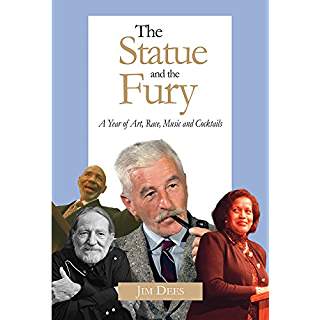
Ron Shapiro ran for mayor, but Pat Lamar won the election. Taylor Grocery changed hands. Ole Miss football coach Tommy Turberville asked students not to wave Rebel flags at football games. A middle-aged cub reporter for the Oxford Eagle interviewed Willie Nelson. And the site for his hometown’s statue of William Faulkner was announced: on the Square, in front of Oxford’s City Hall.
In this lively, thoughtful book, The Statue and the Fury, Oxford writer Jim Dees follows the controversy that swirled around Faulkner’s statue. Some citizens objected to the City Hall site because it meant cutting down a magnolia tree. (“I’d take Mr. Faulkner over a tree any day,” responded Chester McLarty, a proponent of the statue.) Faulkner’s relatives wanted the statue placed at his grave in St. Peter’s Cemetery, or amid the wisteria at Rowan Oak. (“The Faulkners were a spirited bunch and capable of returning fire if they thought they were being threatened,” Dees observes.) It would take nine months of discussion before the magnolia was felled, the statue cast and townspeople came to terms with each other.
Dees draws his title from Faulkner’s most challenging book. “I believe a forced feeding of too much Faulkner might be the way to go for the novice Faulkner student,” he writes.
An intense reading of Faulkner while living in his town is a seminar of ghosts . . . . When Faulkner describes how the afternoon heat slants off the northwest side of the Square, you can walk to that spot and sweat. You’ll pass under Gavin Stevens’ law office on your way back and then, “the cloud” itself, the courthouse. You can get chill bumps reading about the corpse propped up in bed in “A Rose for Emily” and then go visit her neighbors. You can walk out to Rowan Oak and see the east gallery, hidden behind hedges, where the great man would enjoy a late-afternoon gin and tonic.
This book retells what happened in Oxford in the year 1997, but this is no mere chronology. With a sure hand, Dees shapes the events of the year into a spiral of recurring themes. Like a portent of change, the Hale-Bopp Comet blazes across the sky above Rowan Oak. Willie Nelson and James Brown play Tunica; Sam Phillips of Sun Records comes to the Center for the Study of Southern Culture. Motee Daniels, who bragged of being Faulkner’s bootlegger, dies. James Meredith and Johnny Cochran come to town. Jackson Avenue is widened with bulldozers, and a handful of vehement protestors go to jail.
It was in 1997 that Dees began writing for the Eagle. One of his first assignments was to write the obituary of Howard Duvall. The statue controversy was his longest running story. After the disputes of springtime, Dees traveled with sculptor Bill Beckwith to bring Faulkner’s statue from the foundry and cover the dedication, where Shelby Foote and Willie Morris spoke.
Dees’ time as a reporter serves him well. His writing is crisp. He sums up a county lawman as “a bear with a crew cut who had decided not to eat what he’d just caught.” The Oxford town Square, Dees remarks, looks “neat and picture perfect, Disney World meets Harper Lee.” He sketches characters with a novelist’s skill: particularly memorable are the portraits of Ron Shapiro, Evans Harrington and Chester McLarty – who was not only Faulkner’s doctor, but a veteran doctor who had delivered a thousand babies. Oxford is fortunate to have such a keen-eyed historian.
The Statue and the Fury is a snapshot portrait; it captures a world and a year within a single frame. The statue has settled now into its ordered place, a landmark in Oxford’s cityscape and an anchor of the city’s culture. And yet many readers will recall that tempest, and other controversies of that time, and see how choices made twenty years ago continue to echo. The past so skillfully captured in this book, as one onetime Oxford resident could have told us, isn’t even past.
 Allen Boyer, a lawyer and writer who lives on Staten Island, is a native of Oxford. Boyer, who claims to be a veteran of the Worst of Bad Faulkner contest, was a senior appellate counsel for the New York Stock Exchange Division of Enforcement.
Allen Boyer, a lawyer and writer who lives on Staten Island, is a native of Oxford. Boyer, who claims to be a veteran of the Worst of Bad Faulkner contest, was a senior appellate counsel for the New York Stock Exchange Division of Enforcement.
For questions or comments, email hottytoddynews@gmail.com.
